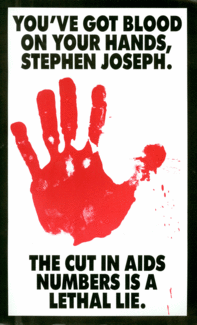
Gran Fury: Art is Not Enough Gran Fury
Dates : Vendredi 23 février 2024 - Dimanche 9 juin 2024
Adresse : MASP - Museu de Arte de São Paulo Assis Chateaubriand , Avenida Paulista, 1578 – Bela Vista, 01310-200 São Paulo
MASP - Museu de Arte de São Paulo Assis Chateaubriand
Avenida Paulista, 1578 – Bela Vista
São Paulo-SP
01310-200
Brésil
Description, horaires...
MASP — Museu de Arte de São Paulo Assis Chateaubriand presents, from February 23 through June 9, 2024, the exhibition Gran Fury: Arte não é o bastante [Gran Fury: Art is Not Enough], which occupies the gallery on the 1st underground floor of the museum. Curated by MASP curator André Mesquita, with the assistance of David Ribeiro, the exhibition features 77 works, including photocopies and digital prints on paper. The exhibition discusses the limits and scope of the Gran Fury collective's graphic campaigns, as well as the idea of art as a strategy in activism, driven by queer people, to raise awareness about HIV/AIDS.
Gran Fury (New York, 1988-1995) was an artist collective regarded as a reference for the practice of activist art in the 1980s and 1990s, which emerged from the organization ACT UP (AIDS Coalition to Unleash Power), formed by individuals and affinity groups dedicated to raising critical public awareness of the US government's silence and negligence in relation to HIV/AIDS. Gran Fury produced graphic campaigns and public interventions around issues related to the HIV/AIDS crisis, visually serving ACT UP in protests and civil disobedience actions. The collective ceased its activities in 1995, and its archive can be found at the New York Public Library.
For much of its history, Gran Fury included Avram Finkelstein, Donald Moffett, John Lindell, Loring McAlpin, Mark Simpson (1950-1996), Marlene McCarty, Michael Nesline, Richard Elovich, Robert Vazquez-Pacheco and Tom Kalin. The group described itself as a “nonpartisan group of diverse individuals united in anger and committed to direct action to end the AIDS crisis.” Its members refused to accept themselves as artists or appear as individual creators and wanted to escape the established art spaces.
The title of the MASP exhibition Art is Not Enough, is inspired by the phrase “With 42,000 Dead, Art Is Not Enough” (1988), written by the collective. The phrase came about when The Kitchen – an independent experimental art and performance institution in New York – invited the collective to design the cover of their calendar, and the collective responded with a poster containing the statement, concluding with “Take Collective Direct Action to End the Aids Crisis.”
“Gran Fury is part of an activist history of the politicized use of communication tools and the subversion of dominant images and discourses, opening up territory for what in the 1990s became known among activist art collectives and social movements as ‘tactical media,’ which is the production of a new type of aesthetic by groups and individuals who are oppressed or excluded from mainstream culture, working with expanded forms of cultural distribution and semiotic intervention in the streets, using different visual mediums,” explains curator André Mesquita.
Among the actions produced by the group was the creation of The New York Crimes (1989), which consisted of printing thousands of copies of a four-page newspaper with texts by ACT UP, with its own news and dense graphics. In this piece, the group mimics the graphic elements of the cover of The New York Times. The New York Crimes corrected the mistaken identities and information reported in the traditional New York newspaper's coverage of the disease, such as that HIV control had stabilized. At the time, Gran Fury and activists from ACT UP took to the streets of New York in the early hours of the morning, opened up boxes of The New York Times, removed the copies and replaced the front pages with the fake newspaper.
In Kissing Doesn’t Kill (1989-90), Gran Fury diverted the corporate multiculturalism of the Benetton clothing company’s famous campaigns, subverting their visual and semantic codes and their visual seduction, to show photographs of three interracial couples kissing. The poster was installed on the sides of buses and in subway stations in San Francisco, Chicago, New York and Washington DC in the United States. The image, also replicated in short videos produced by the collective, was not selling a product, but challenging the misinterpretation of kissing as being risky behavior since, at the time, saliva was seen as a fluid supposedly capable of transmitting HIV.
“The non-advertising billboard of Kissing Doesn’t Kill exemplifies what, in the 1990s, became popularly known as culture jamming; the subversion, manipulation or symbolic disruption of advertising messages in the media and urban space,” explains Mesquita.
The assurance of care and respect for all people with HIV was addressed in a poster with the phrase All People With AIDS Are Innocent (1988), breaking the moral paradigm that some people deserved HIV/AIDS more than others. The Gran Fury poster called for an immediate change in society’s stance to respect, without hierarchies, all people living with HIV/AIDS, who should have the right to equal care and assistance.
According to curator André Mesquita, "saying that ‘art isn't enough’ doesn't mean permanently abandoning art in favor of militancy or pointing out the ineffectiveness of an artistic practice for social transformation. On the contrary, what Gran Fury proposes is that it is no longer enough to make art about the crisis, but that times of crises are also revolutionary moments of radical imagination and confrontation of hegemonic and oppressive systems.” “Its graphic work provokes us to think about the need and urgency for artists, activists and cultural agents to articulate themselves as a political force in solidarity towards direct action, walking alongside protest movements,” he concludes.
Gran Fury: Art is Not Enough is part of MASP's annual program dedicated to Histories of LGBTQIA+ diversity. This year's program also includes exhibitions by Francis Bacon, Mário de Andrade, MASP Renner, Lia D Castro, Catherine Opie, Leonilson, Serigrafistas Queer and the large group show Histories of LGBTQIA+ Diversity.